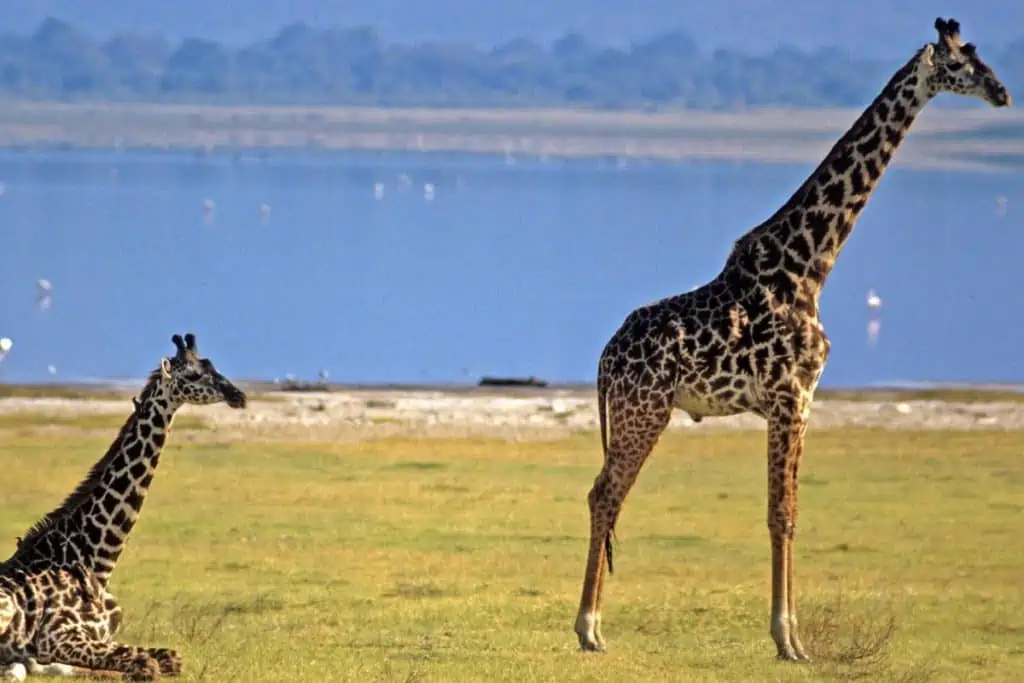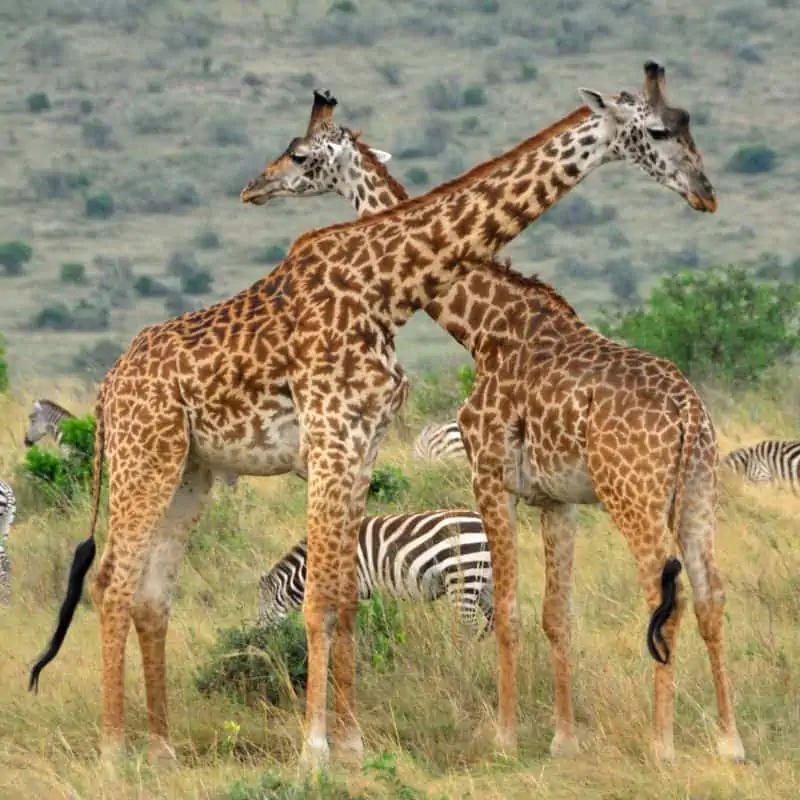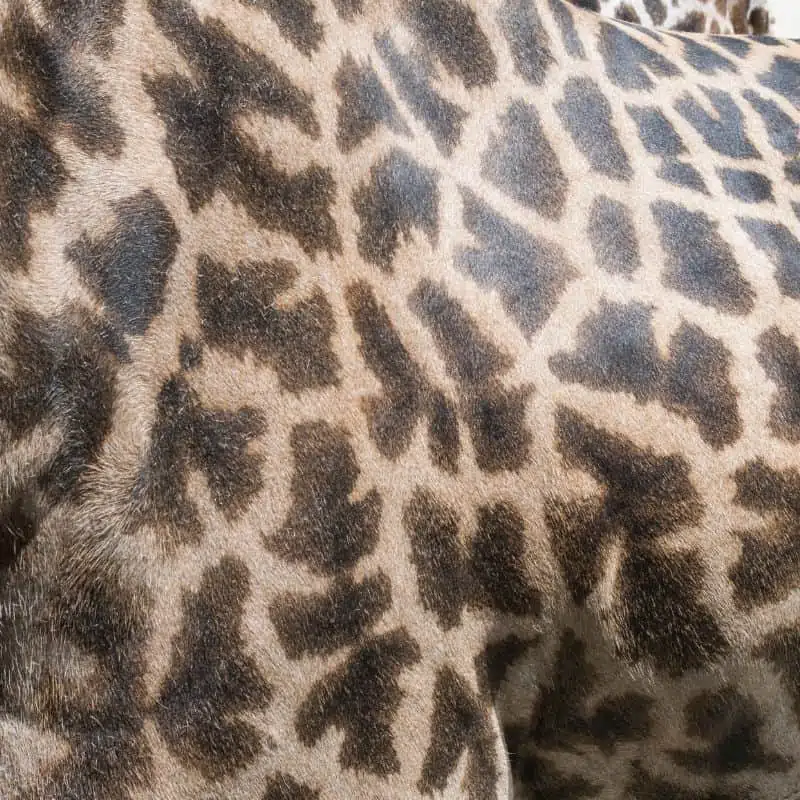Masai giraffes are one of the most iconic animals on the African continent. With their tall stature and long necks, they are easy to spot in the wild.
Here are ten facts about these fascinating creatures that interest anyone with interest in wildlife.

- Holds The Record For Tallest Giraffe Ever Recorded
- Spots Like Jagged Stars
- The Masai Giraffe Is Tanzania’s National Animal
- Designed To Be Nature’s Watchtower
- Masai Giraffes Are Surprisingly Fast
- Normally Docile But Can Be Fierce Protectors
- They Don’t Necessarily Need To Drink Water
- Oversized Giraffes
- They Have A Very Efficient Cooling System
- An Efficient Eating Machine
- Final Thoughts On The Masai Giraffe
- FAQs
Holds The Record For Tallest Giraffe Ever Recorded
To say the giraffe is tall is an understatement. But can a giraffe truly be taller than its peers?
At one time, the Masai giraffe held the title of the tallest giraffe in the world when George, a Masai bull, was measured to stand at 19 feet.
He was a resident of the Chester Zoo in the UK from January 8, 1959, until his death on July 22, 1969.
The tallest living giraffe, Forest, only stands at 18 feet 8 inches. But at only 12 years old, he will probably grow taller than George. If not, one of his 12 offspring probably will.
Spots Like Jagged Stars
Masai giraffes are very easily distinguished from other giraffes with their unique jagged, star-like blotches.
These spots cover the Masai giraffe from head to foot, ranging from light tan to dark brown.
The Masai giraffe looks orange from a distance due to its skin pattern coloring gradations. This allows them to disappear from sight when standing still against the dry grassland areas they frequent.
The Masai Giraffe Is Tanzania’s National Animal
Of the many animals found in Tanzania, the Masai giraffe was chosen to represent the country.
This is an honor as animals like the lion and cheetah, both majestic-looking cats, share the same area where Masai giraffes roam.
Designed To Be Nature’s Watchtower
The Masai giraffe’s considerable height gives it a great vantage point to spot threats from afar.
Paired with binocular positioned eyes and near 180 degrees field of vision gives them the visual advantage to evade predators like lions before they get too near.
It has been noted that other herbivores actively seek out the giraffe for added protection. When a giraffe runs, everyone else follows.

Masai Giraffes Are Surprisingly Fast
People think of the giraffe as a slow-moving creature. Normally, the giraffe stays in one spot to eat the leaves off the top of Acacia trees and moves on to the next tree when none are left.
Giraffes are deceptively slow-moving when walking in this manner, but if you consider the length of their legs, they take enormous strides that quickly cover a lot of ground.
Giraffes can also run when the need arises and can hit a speed of 37 mph (approximately 60 kph) for a limited time.
Normally Docile But Can Be Fierce Protectors
When push comes to shove, the Masai giraffe can deliver a deadly kick that can flatten a lion. Their size, muscular legs, and speed at which the kick is delivered will make any predator think twice before trying again.
Adult giraffes can fiercely protect their young and stomp the ground to warn off potential threats.
If this doesn’t work, a giraffe will charge and deliver a kick or trample the threat as best as it can with its long, powerful legs.
They Don’t Necessarily Need To Drink Water
Giraffes, like camels, are very efficient creatures. They get their food and water from the leaves they munch on.
Giraffes can drink water from rivers or streams but are extremely suspicious of these bodies of water as they could contain crocodiles.
When drinking, they put themselves in a very vulnerable state and can’t defend themselves properly if something should try to grab them.
Oversized Giraffes
The Masai giraffes are the largest representatives of the giraffe family. They have hearts that weigh 25 pounds, eyes the size of golf balls, and hooves 12 inches across.
The most obvious physical features that make giraffes oversized animals are their long neck and legs.
They also easily tip the scales at 2600 pounds and maintain this weight by eating 75 pounds of food per day. They can weigh more if food is abundant, like in zoos where people enjoy watching them gently amble along.
They Have A Very Efficient Cooling System
The Masai giraffe has a very efficient cooling system to prevent itself from overheating.
They can direct blood to the vessels at the very edge of their spots to let excess heat escape.
And giraffes will also stand facing the sun to maintain a slimmer profile. This allows them to keep everything else in the shade with their neck alone.

An Efficient Eating Machine
Masai giraffes are excellent eating machines that can derive all of their nutritional needs from the leaves they eat.
To do this, they must first get the leaves into their mouths. To aid them in gathering leaves, giraffes have long, prehensile tongues designed for long sun exposure periods.
This tongue has an excess of melanin to combat the effects of sunburn. Their lips are extremely tough and flexible for handling thorns, and they have a hard palate for separating the leaves from branches.
Like most herbivores, giraffes have a well-developed stomach where food can be stored and/or regurgitated for munching. This ensures the giraffe will get the full nutritional value from its food.
Final Thoughts On The Masai Giraffe
Now that you know some fascinating facts about the world’s tallest animal, the Masai Giraffe, be sure to keep an eye out for them on your next African safari adventure.
Although they are gentle giants, it is still impressive to watch them in action and marvel at their size.
And remember, when you see one of these magnificent creatures, you are seeing Tanzania’s national animal.
FAQs
What Do You Call A Herd Of Giraffes?
Giraffes in herds are most commonly referred to as a “tower.” Groups of giraffes are also sometimes called a “journey,” a “kaleidoscope,” or just a plain old “herd” of giraffes.
What Other Purpose Do Giraffe Necks Serve?
First, a giraffe’s neck can easily reach the top of trees. This reduces the number of competitors they have for food. Second, bulls will use their necks as clubs to defend their territory or ward off rivals for mating. Lastly, the neck can provide shade to the rest of the body.
Where Do Masai Giraffes Live?
The Masai Giraffe is native to East Africa and most commonly found on the savannas of Tanzania and Kenya.
